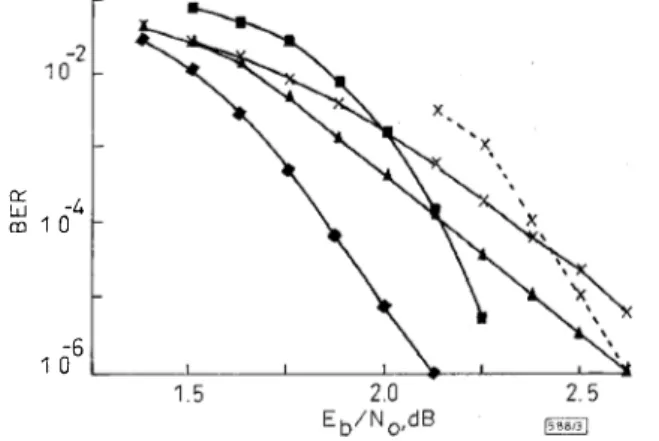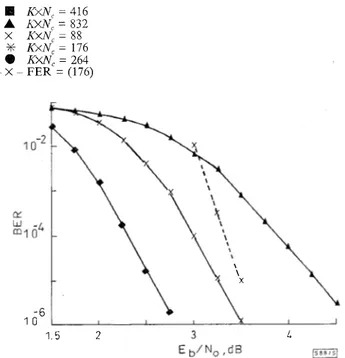HAL Id: hal-02489028
https://hal.archives-ouvertes.fr/hal-02489028
Submitted on 24 Feb 2020
HAL is a multi-disciplinary open access
archive for the deposit and dissemination of
sci-entific research documents, whether they are
pub-lished or not. The documents may come from
teaching and research institutions in France or
abroad, or from public or private research centers.
L’archive ouverte pluridisciplinaire HAL, est
destinée au dépôt et à la diffusion de documents
scientifiques de niveau recherche, publiés ou non,
émanant des établissements d’enseignement et de
recherche français ou étrangers, des laboratoires
publics ou privés.
Performance of hybrid turbo codes
Patrick Adde, Ramesh Pyndiah, Claude Berrou
To cite this version:
Patrick Adde, Ramesh Pyndiah, Claude Berrou. Performance of hybrid turbo codes. Electronics
Letters, IET, 1996, 32 (24), pp.2209 - 2210. �hal-02489028�
Performance of hybrid turbo codes
P. Adde,
R.
Pyndiah and C. BerroUIndexing terms: Turbo codes, Convolutional codes, Block codes
The authors present the latest results on turbo codes which are built from a serial concatenation between a block code (BCH) and a recursive systematic convolutional code. The performance on a Gaussian channel with QPSK modulation is evaluated. Introduction: In 1993, Berrou et al. [l ] showed that it was possible to transmit digital information at a rate close to channel capacity as predicted by Shannon in 1948 [2]. For this, a coding scheme based on the parallel concatenation of two recursive systematic convolutional (RSC) codes was used, associated with an original iterative decoding algorithm. This iterative decoding algorithm uses soft input and output decoding of the component codes. In 1994, Pyndiah et al. [3] proposed a new iterative decoding algo rithm for decoding product codes, introduced by Elias [4] in 1954. This iterative decoding algorithm is also based on soft input and output decoding of the component codes. This new coding scheme showed exceptional performance for high code rates, typically for R > 0.75. This new concept is known as a 'turbo-code' and is widely accepted [5]. In this Letter, we investigate the performance of iterative decoding in the case of a block code ( extended BCH) serially concatenated with a convolutional code (RSC).
N r(J.NS
N c columns parity redundancy
data
Fig. 1 Construction of hybrid turbo code
Ny columns y
redundancy 0 f RSC
Construction of encoder: We consider the extended BCH (N, K, 6). The hybrid turbo code is obtained by placing N,K information bits in an array of K rows and N, columns. The N, columns are
encoding by an extended BCH code. This new matrix (N, columns of N symbols) is used as an interleaver. Every row is encoded by the RSC code, with code memory v, as illustrated in Fig. 1. The redundancy Y of this code can be punctured: it is organfaed as Ny
columns of N symbols. The code rate R of the hybrid turbo code IS
R= KNc N(Nc
+
Ny)where KIN= RocH is the BCH code rate and N/[N, + Ny] = RRsc
is the RSC code rate.
15 2.0 2. 5
Eb/N0, dB ê!mJ
3.0
Fig. 2 BER for BCH (32, 26, 4) and RSC (23, 35) with q = 4, R = 1/2
and after four iterations
+
iteration 2 X iteration 3 .À. iteration 4Bit error rate ( BER) against signal ta noise ratio on a Gaussian channel: lterative decoding requires reliability information at the decoder outputs: for RSC codes, the Viterbi-based algorithm described in [6] is used and for extended BCH codes, the measure ment of reliability is obtained from the log likelihood ratio estima tion (LLR) [3]. Fig. 2 gives the BER of the hybrid turbo code built with extended BCH (32, 26, 4) and RSC (23, 35) code. The sym bols are encoded using q = 4 bits ( one bit for the sign and three for its reliability) and the global code rate is R = 1/2.
O:'. -4
iii
1 0 -6 1 0Fig. 3 Performance of different hybrid turbo codes with q = 4, R = 112 and a/ter four iterations
+
CC (133, 171) and BCH (64, 57, 4) • CC (133, 171) and BCH (64, 51, 6) .À. CC (23, 35) and BCH (64, 57, 4) X CC (23, 35) and BCH (32, 26, 4) - X - CC (133, 171) and BCH (255, 233, 16)Using the same code rate, we can associate different extended BCH coding with RSC v = 4 (23, 35) or v = 6 (133, 171). The results are reported in Fig. 3. The signal to noise ratio for a BER
of 10-5 at iteration 4 is 2dB from Shannon's theoretical limit for
the serial concatenation of BCH (64, 57, 4) and RSC (133, 171). We compared this association with the serial concatenation of the Reed-Solomon code RS (255, 223, t = 16) and convolutional code CC (133, 171) [7] (in this case, the code rate is lower: 0.43). The coding gain is -0.5dB for the hybrid turbo code.
Variations with size of frame: If N, is modified, the size of the frame changes. Fig. 4 gives the BER for two hybrid turbo codes: (i) BCR (32, 26, 4) and RSC (23, 35) with 416 and 832 bit frame sizes
(ii) BCH (16, 11, 4) and RSC (23, 35) with 88, 176 and 264 bit frame sizes
For a 176bit frame size, we have added the curve which gives the frame error rate (FER). Thus, hybrid turbo codes can be used for short blocks.
10 O
1
o·
6 '---'---'---'---�--�--�2 l
Fig. 4 BER against frame size and signal ta noise ratio with q = 4, R =
1/2 and a/ter four iterations
Il KxN, = 416 .À. KxN, = 832 X KXN, = 88
*
KXN, = 176 9 KXN, = 264 - X - FER = (176) -6 1 0 1.5 2 \ \ X lFig. 5 BER against code rate and signal ta noise ratio for BCH (32, 26, 4) and RSC (23, 35) with q = 4 and a/ter four iterations (R = 1/2, 2/3 and 3/4)
+
R = 1/2 X R = 2/3 .À. R = 3/4- X - CC (133, 171 and R = 3/4) and RSC (255, 239, 8)
Variations with Ny: By puncturing Y, it is possible to change RRsc
(and R). Fig. 5 gives the BER of the concatenation of BCH (32, 26, 4) and RSC (23, 35), against different code rates. The results of the hybrid turbo code are cornpared with the serial concatena tion of CC (v = 6, R = 3/4) and RS code (255, 239, t = 8), used for digital HDTV [8].
Conclusion: We have given some results conceming the perform ances of hybrid turbo codes. They indicate that this séria! concate nation can favourably replace the 'standard scheme' built with a CC and RS code. We also showed that they could be used for short blocks.
P. Adde, R. Pyndiah and C. Berrou (Télécom Bretagne, Technopôle Brest Iroise, BP-832, 29285 Brest, France)
E-mail: patrick.adde@enst-bretagne.fr
References
BERROU, c., GLAVIEUX, A., and THITIMAJSHIMA, P.: 'Near Shannon
limit error-correcting coding and decoding: Turbo-codes'. IEEE Int. Conf Comm. ICC'93, May 1993, Vol. 2/3, pp. 1064-1071 2 SHANNON, C.E.: 'A mathematical theory of communication', Bell
Syst. Tech. J., July 1948, 27, pp. 379---423 (and pp. 623-656, October 1948)
3 PYNDIAH, R, GLAVIEUX, A., PICART, A., and JACQ, S.: 'Near optimum
decoding of products codes'. Proc. IEEE GLOBECOM'94 Conf., San Francisco, November-December 1994, Vol. 1/3, pp. 339-343 4 ELIAS, P.: 'Error-free coding', IRE Trans. Inf Theory, Sept. 1954,
IT-4, pp. 29-37
5 'Special Issue on Turbo-Decoding', European Transactions on Telecommunications, September-October 1995, 6, (5)
6 BERROU, C, ADDE, P., ANGUI, E., and FAUDEIL, S.: 'A low complexity
soft-output Viterbi decoder architecture'. Proc. IEEE ICC'93, Geneva, May 1993, pp. 737-740
7 POLLARA, F., and CHEUNG, K.-M.: 'Performance of concatenated
codes using 8-bit and 10-bit Reed-Solomon codes'. TDA Progress Report 42-97, January-March 1989, pp. 194-201
8 MORELLO, A., MONTORSI, G., and VISINTIN, M.: 'Convolutional and
trellis coded modulations concatenated with black codes for digital HDTV'. Audio video digital radio broadcasting systems and techniques, Proc. 6th Tirrenia International Workshop on Digital Communications, Tirrenia, 5-9 September 1993, pp. 237-250

